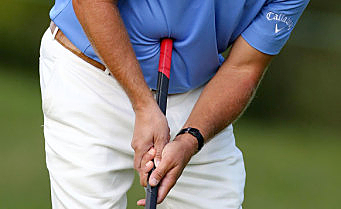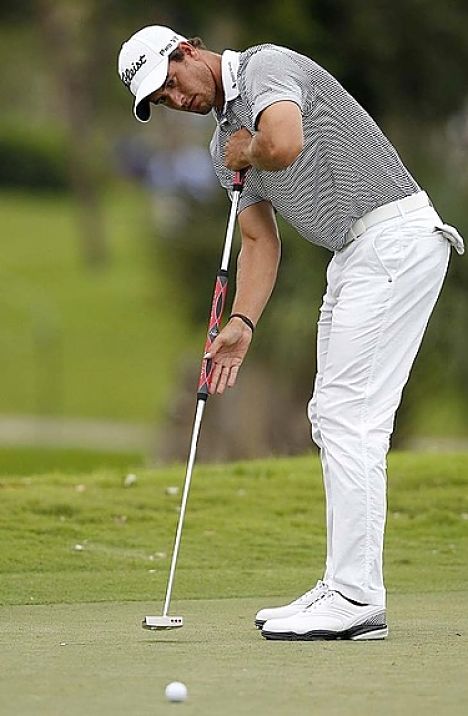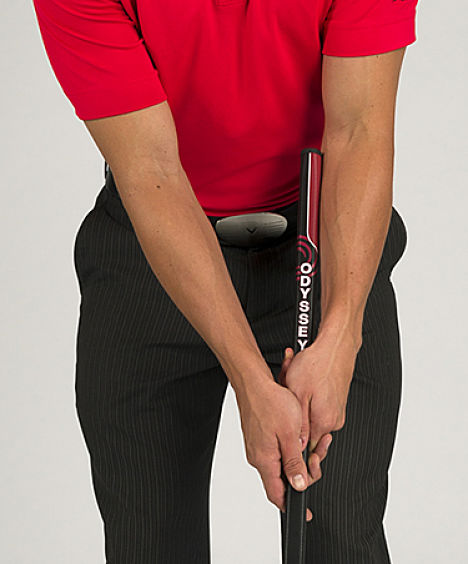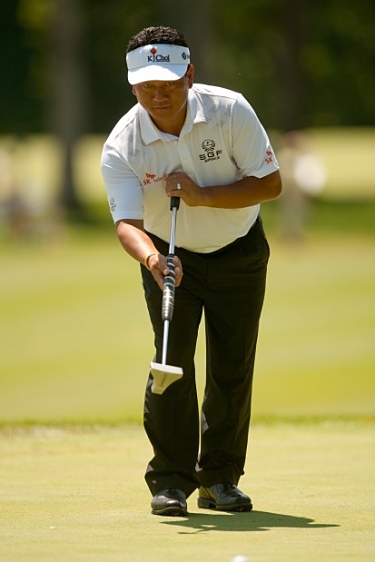Short-History-of-Long-Handled-Golf-Putters-Why-Banned-in-2016
Golf's ruling bodies have moved to ban the use of anchored long-handled putters from 2016, not because they are long, but because it is considered unfair for players to anchor the top of the club against the belly, chest (sternum), or arm when putting.
Players have been using the broomstick putter, anchored at the chest, for more than 20 years. In recent years a shorter version, the belly putter, anchored at the stomach, has become the more popular.
Both these types of clubs and putting styles are designed to overcome wobbly wrists and forearms when putting. It forces the player to make the stroke by swinging the entire torso not just the arms. It has helped many golfers to overcome the ‘yips’.The anchoring of any golfing stroke to a pivot point during a golf swing will be banned from 2016.
The ban arose because of the increased popularity and effectiveness of the clubs with three of the five majors in 2012 won by players using longer putters. Many had claimed that anchoring clubs during strokes was cheating, and contrary to the spirit of the game.
The growing outcry caused the US Golf Association and the Royal & Ancient Club to recommend the ban. The growing prevalence of the clubs amongst teenagers who had qualified for major events may have triggered the response (a 14 year old player has qualified for the 2013 Masters using a belly putter).
The authorities ruled that there was a risk that anchored strokes could supplant traditional putting strokes. Under the new rules extended length putters would still be permitted provided the players used them with free swing away from the body and without any anchor points to the chest, belly or arms.
Anyone who breached the new rule would be incur a 2-shot penalty during strokeplay events or would lose the hole in matchplay.
This article outlines the history of the Long Putter and why the use of anchoring points have been banned.





History of Long Putters and Use of Anchoring Points
A history of long-putters and the use of anchor points is described in the table below. Long-handled putters have been used for more than 30 years. Many players adopted them to overcome the yips and other problems with putting that threatened to end many promising careers. Many players who shifted to longer putters, were able to remain competitive and to continue their professional golfing careers.
However, their popularity has increased dramatically over the past two years. It is estimated that about 15% of professionals now use anchored long -putters this method. Recent event results have highlighted the shift from a technique to overcome injuries or the yips to becoming a mainstream technique. Many have claimed ‘Enough is Enough’
- Keagan Bradley won the 2011 PGA Championship with a belly putter.
- In June 2012 Webb Simpson, playing at The Olympic Club, was crowned the winner of the U.S. Open. He used a belly putter.
- July 2012 Ernie Els used a belly putter to win the British Open. The runner-up was Adam Scott, who used a broomstick putter anchored to the sternum.
- Almost one third of the British Open Field in 2012 (43 of 156 players) used either a long or belly putter.
- November 2012 Tianlang Guan, aged 14 at the time, won the Asia Pacific Amateur Championship using a belly putter, earning an invitation to play in the 2013 Masters event (the youngest player ever to qualify). This win and qualification for the Masters by such a young player may have been the final straw that triggers golf's governing bodies to finally act to ban anchored putting actions.
What are the Advantages of Long-Putters when Anchored
Many people have made the valid point that the genie was let out of the bag long ago. If long-putters were going to be banned, it should have happened 20-plus years ago. Many people have modeled their games around the long-putter and have been using anchoring for 5 and even 10 years. The long putter has been permitted for so long, why make the changes now?
Many have argued that the long-putter and anchoring points have allowed many players with injuries and ailments to continue to play the game, including those who developed the yips, lost control over the muscles in the wrists and lower arms and simply lost confidence in putting. Many older golfers use theme. But the recent explosion in popularity has clearly extended beyond overcoming injuries and disabilities, especially when teenagers just entering the professional ranks are using them. Traditionalists in golf, including many of the leading professionals such as Tiger Woods, argue that anchoring putters to the body threatens to fundamentally change golf.
There is a truly unbelievable array of putter head designs that are permitted within the rules. The problem is just at the other end. The Rules of Golf specify that a putter cannot be shorter than 18 inches, but there's no maximum length (although there is a maximum for other clubs of 48 inches). However there is an existing general rule stating that equipment must maintain "traditional and customary" use. This is probably the lever for applying the new rule to anchoring points.
Many stroke and equipment rules have been changed in the past. It was decided over 100 years ago that the ball must be fairly struck and not be spooned, pushed or scraped. The croquet style putter was banned in 1968, but many weird head designs have been allowed, including the metal driver. Also there have been rules on maximum club length (48 inches, but not for putters).
The fundamental principle driving the rule change is that all golf strokes were meant to be played with hands and arms away from the body. Anchoring a putter against body provides a third point of contact between golfer and club apart from the two hands. This anchoring creates a fulcrum for allowing a pendulum like stroke. Many people believe only the hands should connected to any golf club and anchoring to the body provides an unfair advantage, which goes against the ethos and spirit of the game. Many claim that this is paramount to cheating.
The proposed new rule would apply for all levels of the game of golf.
The proposal is for Rule 14-1(b) to be inserted which reads, "In making a stroke, the player must not anchor the club, either 'directly' or by use of an 'anchor point."
The anchoring is defined as players intentionally gripping the club with the hands, or directly so that it contacts any part of the body.
Putting grips such as "cross handed" or "claw" or are still permitted. Long putters would still be permitted. A belly putter style or a moderate length putter, which is held against an arm would still be allowed, provided they don't touch the stomach (Angel Cabrera used this style when he won the 2009 Masters). Broomstick putters, such as used by Adam Scott, would be permitted provided the handle and hand holding it, are held away from the chest and is not secured against the torso.
Why Make the Rule Change to Prevent Contact with the Body during Putting?
With a conventional putter the left and right arms are used during the putting stroke, meaning that two pendulums must be controlled. The flexible wrists provide to additional flex points that add to the instability. By anchoring the end of the putter club against the body, securing it, there is only one lever in the swing and stroke. This removes flexibility and ensure a more direct and consistent pendulum action when contacting the ball.
What are the Disadvantages of Long Putters
Comparing conventional putter with belly and broomstick putters, the conventional short putter has the best feel, but the shaft has least stability through the stroke. The long putter has lateral stability, but much less feel with such a long club and long pendulum swing. The belly putter is somewhere in between. Moving away from the conventional putter invariably means some loss of feel and control of stroke strength (distance) but better control of direction. Some have claimed that there is a progression with age from standard putter, to belly putter, and then long broomstick putter. Bernard Langer who battled with yips made this progression.
The Belly Putter
The belly putter stroke has a third point of contact, apart from the two hands - the abdomen, which provides balance and stability to the stroke. Wrist action is easier to control. The player assumes in an ideal posture and pivots the body rather than just the arms. The risk of forwards or backwards movement away from the body is eliminated. Wrist action is also minimized during the pendulum action.
The Long Putter Anchored to the Sternum, Stomach or Chest
The long putter is easier and less tiring to us during play and practice because the golfer adopts a more upright stance. This puts less strain and pressure on the back muscles and provides a better line of sight to the hole. It is a better option for people with back and leg injuries, and other ailments, that make bending difficult
The long putter turns the putting stroke into a true pendulum swing, totally eliminating wrist hinge. The body swivels during the stroke.
However the extreme length of the long putter (48-52 inches) means even less feel and feedback for the power and distance control for the stroke than for the belly putter. This means that controlling distance becomes a bit more problematic.
Players and Manufacturers Responses
A three-month consultation process is underway on the proposed rule change during which manufacturers and players can provide comments.
There has already been some reaction from the players and club manufacturers. The long-putter itself has not been banned. Some manufacturers are already exploring ways to allow anchoring while still being within the rules. One example is the arm-brace putter that is designed to be held against the forearm when putting.
Some players may decide to keep using their long-putters but with a free swing, as was used by Angel Cabrera when he won the Masters in 2009. Adam Scott has started experimenting with shorter clubs, but is undecided whether or not the change, or to simply keep the putter away from his chest. Meeting the new rules may not involve having to change clubs, but may only involve minor changes to techniques. Adam Scott said that all he had to do was to keep his top hand off his chest by an inch or a centimetre for his stroke to be within the new rules. It may be very hard to enforce some of these very subtle changes and to monitor hand and club positions and apply the two-stroke penalty. It is not as obvious as the croquet style putter that was banded in 1968 , even though Sam Snead used this club.
Hostory of Anchored, Long-Handled Golf Putters
|
Year
|
Event
|
|---|---|
|
1924
|
Leo Diegel develops 'Diegeling' which involved having the butt of the putter held against the his belly button and adopting a bent-over stance with elbows held out away from the body.
|
|
1965
|
The first patent for a 'belly' golf putter, submitted by Richard Parmley, was approved.
|
|
1966
|
A golfer named Phil Rodgers wins two PGA Tour events with a long putter (about 40 inches) used with handle of his putter held against the stomach.
|
|
1968
|
The U.S. Golf Association bans a croquet-style putting club and action that was trialled by several famous players at the time including Sam Snead. It was banned because of its unconventional style of putting and the threats to the game from other equally bizarre strokes and clubs.
|
|
1983
|
Charlie Owens, afflicted by bad knees won twice on the tour in 1986 using a 51-inch putter anchored to the sternum.
|
|
1987
|
Johnny Miller, used a 46-inch long putter, to win the Pebble Beach National Pro-Am. The club was braced against his left arm when putting.
|
|
July 1989
|
Orville Moody transformed his game using a long putter to win the U.S. Senior Open, when his game had been previously ruined by poor putting with a conventional club.
|
|
August 1989
|
US Golf Association and the Royal & Ancient Club consider banning long putters but decide against it.
|
|
1991
|
Rocco Mediate became the first player who used a long putter anchored to the sternum to win a PGA Tour event
|
|
2000
|
Paul Azinger won his first PGA Tour event after six failed years after switching to a belly putter.
|
|
2003
|
Long putters start to become more popular with 8 PGA Tour events that year won by players using long putters, including four by Vijay Singh.
|
|
2003
|
Later in the same year, the US Golf Association and the Royal & Ancient Club set a maximum length of 48 inches for all golf clubs except the putter.
|
|
2004
|
Vijay Singh wins nine times on the PGA Tour - six times with a standard putter, three times with a belly putter..
|
|
2009
|
Angel Cabrera won The Masters event using a 39-inch putter, that was not anchored to his body.
|
|
2011
|
Keegan Bradley wins the PGA Championship using a style where the putter was anchored to his body ( the first PGA won using this technique). Bill Haas uses a belly putter to win the 2011 Tour Championship. In that year 7 different players won events on the Tour using various anchored putter.
|
|
June 2012
|
Webb Simpson wins the U.S. Open at The Olympic Club and becomes the second player to win a major using a belly putter.
|
|
July 2012
|
Ernie Els wins the British Open using a belly putter. The runner-up was Adam Scott, who used a broomstick putter anchored to the sternum. Almost one third of the British Open Field in 2012 (43 of 156 players) used either a long or belly putter.
|
|
November 2012
|
Tianlang Guan, aged 14 at the time, won the Asia Pacific Amateur Championship using a belly putter, earning an invitation to play in the 2013 Masters event (the youngest player ever to qualify). This win and qualification for the Masters by such a young player may have been the final straw that triggers golf's governing bodies to finally act to ban anchored putting actions.
|
|
November 2012
|
US Golf Association and the Royal & Ancient Club announce a decision to ban anchored strokes from the start of the 2016 season (1 January).
|